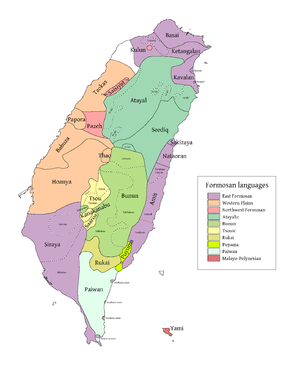Saisiyat language
| Saisiyat | |
|---|---|
| Native to | Taiwan |
| Ethnicity | Saisiyat |
Native speakers | 4,800 (2002)[1] |
|
Austronesian
| |
| Dialects |
Taai
Tungho
|
| Language codes | |
| ISO 639-3 | xsy |
 Saisiyat, Pazeh, and Kulon (pink, northwest) | |
Saisiyat is the language of the Saisiyat, a tribe of indigenous people on Taiwan (see Taiwanese aborigines). It is a Formosan language of the Austronesian family. It has approximately 4,750 speakers.
Distribution
The language area of Saisiyat is small, situated in the northwest of the country between the Hakka Chinese and Atayal regions in the mountains (Wufeng-hsiang, Hsinchu, Nanchuang-hsiang, Miaoli).
There are two main dialects of Saisiyat.
- Ta'ai (Taai)
- Tungho
Kulon, an extinct Formosan language, is closely related to Saisiyat but is considered by Taiwanese linguist Paul Jen-kuei Li to be a separate language.
Usage
Today, one thousand Saisiyat people do not use the Saisiyat language. Many young people use Hakka or Atayal instead, and few children speak Saisiyat. Hakka Chinese speakers, Atayal speakers and Saisiyat speakers live more or less together. Many Saisiyat are able to speak Saisiyat, Hakka, Atayal, Mandarin, and, sometimes, Min Nan as well. Although Saisiyat has a relatively large number of speakers, the language is endangered.
Grammar
Syntax
Although it also allows for verb-initial constructions,[2] Saisiyat is a strongly subject-initial language (i.e., SVO), and is shifting to an accusative language, while it still has many features of split ergativity (Hsieh & Huang 2006:91). Pazeh and Thao, also Northern Formosan languages, are the only other Formosan languages that allow for SVO constructions.
Saisiyat's case-marking system distinguishes between personal and common nouns (Hsieh & Huang 2006:93).
| Type of Noun |
Nominative | Accusative | Genitive | Dative | Possessive | Locative |
|---|---|---|---|---|---|---|
| Personal | Ø, hi | hi | ni | 'an-a | 'ini' | kan, kala |
| Common | Ø, ka | ka | noka | 'an noka-a | no | ray |
Pronouns
Saisiyat has an elaborate pronominal system (Hsieh & Huang 2006:93).
| Type of Pronoun |
Nominative | Accusative | Genitive | Dative | Possessive | Locative |
|---|---|---|---|---|---|---|
| 1s. | yako/yao | yakin/iyakin | ma'an | 'iniman | 'amana'a | kanman |
| 2s. | So'o | 'iso'on | niSo | 'iniSo | 'anso'o'a | kanSo |
| 3s. | sia | hisia | nisia | inisia | 'ansiaa | kansia |
| 1p. (incl.) | 'ita | 'inimita | mita' | 'inimita' | 'anmita'a | kan'ita |
| 1p. (excl.) | yami | 'iniya'om | niya'om | 'iniya'om | 'anya'oma | kanyami |
| 2p. | moyo | 'inimon | nimon | 'inimon | 'anmoyoa | kanmoyo |
| 3p. | lasia | hilasia | nasia | 'inilasia | 'anlasiaa | kanlasia |
Verbs
The following are verbal prefixes in Saisiyat (Hsieh & Huang 2006:93).
| Type of Focus | I | II |
|---|---|---|
| Agent Focus (AF) | m-, -om-, ma-, Ø | Ø |
| Patient Focus (PF) | -en | -i |
| Locative Focus (LF) | -an | — |
| Referential Focus (RF) | si-, sik- | -ani |
Saisiyat verbs can be nominalized in the following ways.[3]
| Lexical nominalization | Syntactic nominalization | Temporal/Aspectual | |
|---|---|---|---|
| Agent | ka-ma-V | ka-pa-V | Habitual, Future |
| Patient | ka-V-en, V-in- | ka-V-en, V-in- | Future (for ka-V-en), Perfective (for V-in-) |
| Location | ka-V-an | ka-V-an | Future |
| Instrument | ka-V, Ca-V (reduplication) | ka-V, Ca-V (reduplication) | Future |
Notes
- ↑ Saisiyat reference at Ethnologue (17th ed., 2013)
- ↑ Li, Paul Jen-kuei. 1998. "台灣南島語言 [The Austronesian Languages of Taiwan]." In Li, Paul Jen-kuei. 2004. Selected Papers on Formosan Languages. Taipei, Taiwan: Institute of Linguistics, Academia Sinica.
- ↑ Yeh, Marie Mei-li. n.d. Nominalization in Saisiyat. Hsinchu, Taiwan: National Hsinchu University of Education.
References
- Hsieh Fuhui and Huang Xuanfan. 2006. "The Pragmatics of Case Marking in Saisiyat." Oceanic Linguistics, Volume 45, Number 1, June 2006, pp. 91–109.
- Li, Paul Jen-kuei [李壬癸]. 1978. A Comparative Vocabulary of Saisiyat Dialects [賽夏方言的比較詞彙]. Bulletin of the Institute of History and Philology [歷史語言研究所集刊], Academia Sinica, 49:133-199.
| ||||||||||||||||||||||||
